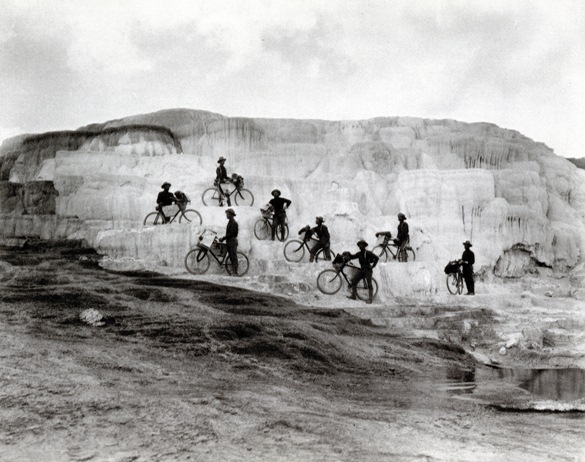Private John Coyle was on duty at Castle Geyser on August 9 when a young lady from California climbed the wall of its cone to look inside. A shift in the wind enveloped her in steam so she could not see to descend and was in danger of falling into the vent of the geyser. Her terrified shrieks brought Private Coyle, who climbed up, wrapped his blue coat about the young lady and brought her safely down, but not without getting seriously scalded in the face. Orders Number 52, issued at headquarters of the 22nd Infantry at Fort Keogh on August 25, 1888, state: “The colonel commanding is pleased to announce to the regiment an act of heroism and gallantry displayed by Private John Coyle, Company B, 22nd Infantry, while on duty in camp at the Old Faithful Geyser, Yellowstone Park.” After reciting the circumstances the colonel concluded, “such commendable and exemplary conduct entitles Private Coyle to great praise, and the thanks of the regimental commander are hereby extended to him.” Private Coyle later received a silver medal for his courageous act.
The silver medal Haines is referring to is in fact a Silver Lifesaving Medal which is equivalent to today’s Soldier's Medal, the highest honor a soldier can receive for an act of valor in non-combat.
The Immortal 15 left one final mark on the park - one of their members was the first to be buried at the Fort Yellowstone Cemetery. Private Thomas Horton, Company C, 22nd Infantry, died on October 1, 1888, of unknown causes, and was interred in the military cemetery just south of Mammoth Hot Springs. Of course, the U.S. Army continued to protect Yellowstone long after 1918. When Yellowstone was threatened by the fires of 1988, the park’s superintendent once again asked for the Army’s help and hundreds of infantrymen answered the call including soldiers from the 23rd Infantry Regiment from Fort Lewis’s (Washington) 9th Infantry Division. When the superintendent needed reinforcements in 1887, he requested support from the infantry, and when the superintendent needed help in 1988, infantrymen again heeded the call.
It’s not clear if other infantry units, or detachments, served in Yellowstone although there are some vague references including one concerning the construction of Fort Yellowstone. As mentioned earlier, when the Army arrived in 1886 the plan was that they would only be in the park temporarily. A headquarters was established at Mammoth Hot Springs and dubbed Camp Sheridan. After five years, and five Yellowstone winters, military leaders realized the need for more permanent accommodations. The first building constructed at Fort Yellowstone was a guardhouse at the southwest corner of the fort, a building still standing today. Construction of the fort was led by Lieutenant Carroll A. Devol, 25th Infantry Regiment, who supervised the civilian workers who built Fort Yellowstone. Members of the 25th Infantry are famously remembered as the Buffalo Soldiers, the nickname for the African-American soldiers of this regiment, although Lieutenant Devel was not African-American.
There is one more infantry unit often associated with Yellowstone: the 25th Bicycle Infantry Corps. This experimental unit was comprised of members of the 25th Infantry “Buffalo Soldiers” stationed at Fort Missoula, Montana. These soldier rode to Yellowstone National Park in 1896 prior to their epic 1,900 mile ride from Fort Missoula to Saint Louis, Missouri, in 1897. Photos of these nine infantrymen, pioneers in many ways, are often seen in Yellowstone, but their names are not remembered - Lt. James Moss, Sgt. Dalbert P. Green, Cpl. John G. Williams, Pvt. John Findley, Pvt. Frank L. Johnson, Pvt. William Proctor, Pvt. William Haynes, Pvt. Elwood Forman, and Musician William W. Brown.
 Postcard, YELL #22865
Postcard, YELL #22865
The Army left Yellowstone in 1918, turning care of the park over to the newly established National Park Service. Since that time, the Army’s contribution to protecting Yellowstone (and other national parks) has been occasionally acknowledged. There was a ceremony in 1986 commemorating the centennial of the Army’s arrival and administration of Yellowstone, and another ceremony in 2000 marking the Army’s 225th anniversary, both held at the site of old Fort Yellowstone in Mammoth Hot Springs.
Of course, the U.S. Army continued to protect Yellowstone long after 1918. When Yellowstone was threatened by the fires of 1988, the park’s superintendent once again asked for the Army’s help and hundreds of infantrymen answered the call including soldiers from the 23rd Infantry Regiment from Fort Lewis’s (Washington) 9th Infantry Division. When the superintendent needed reinforcements in 1887, he requested support from the infantry, and when the superintendent needed help in 1988, infantrymen again heeded the call.Sources: Army Era Records, Yellowstone Park Archives; Battle, David and Erwin N. Thompson. Fort Yellowstone Historic Structure Report (May 1972); Ekey, Robert. “Infantry heads for the fire lines,” Billings Gazette (August 23, 1988); Hampton, H. Duane. How the U.S. Cavalry saved our National Parks (1971); Haines, Aubrey L. The Yellowstone Story: A History of our first National Park, vol. 2 (1996); Livingston Enterprise [newspaper], Yellowstone Research Library; May, Kay. The Great Bicycle Experiment : the Army's historic Black Bicycle Corps, 1896-97 (2012); Returns of Regular Army Infantry Regiments, 1821-1916, National Archives and Records Administration; Whittlesey, Lee. Death in Yellowstone: Accidents and Foolhardiness in the first National Park (1996).
